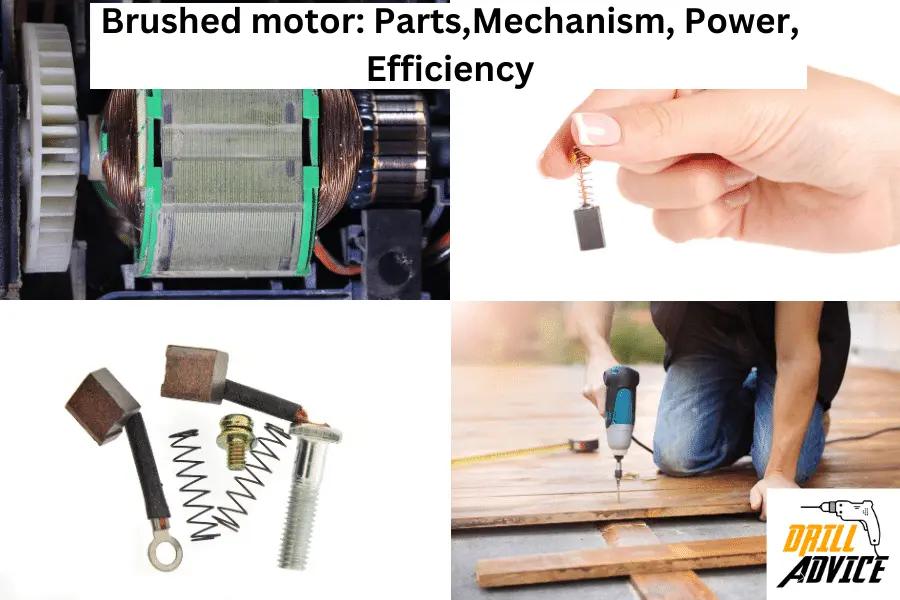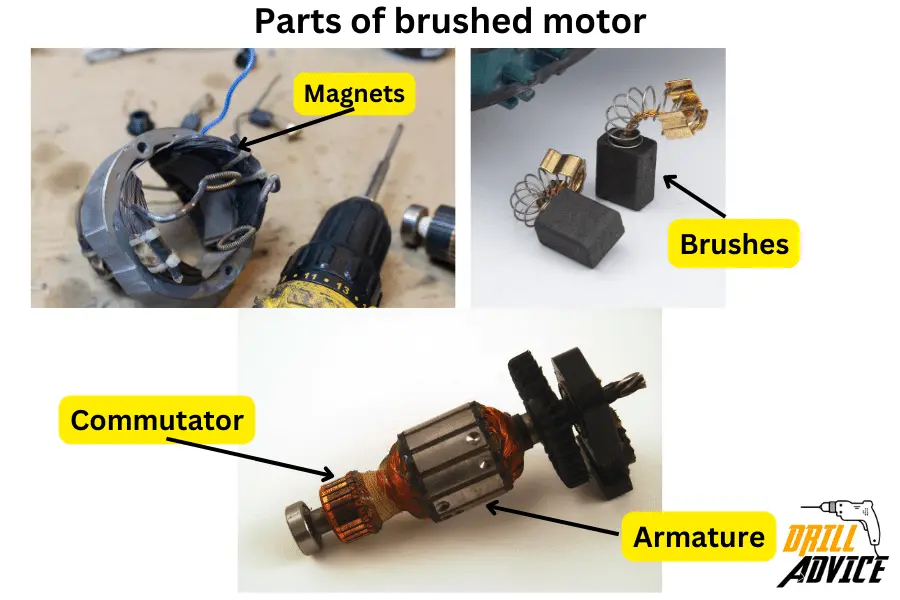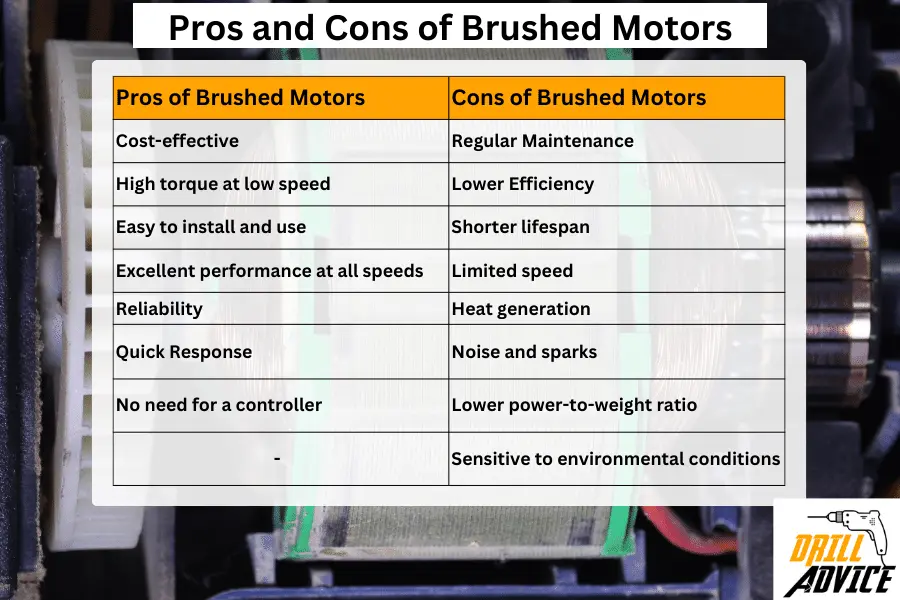
Brushed motors are permanent magnet motors that can operate with a DC voltage power source. The main parts of the brushed motors are copper coils, curved magnets, armature, commutator, and carbon brushes.
The brushed motor is rotating due to the permanent magnetic production in the armature, and it repels from the curved magnets continuously. The commutator provides continuous conductivity between the armature and brushes during the rotation. The brushes provide the DC voltage from the power source.
The torque of the brushed motor depends on the current, and the speed of the brushed motor depends on the voltage. Therefore the torque of the motor can be increased by improving the current of the motor. The efficiency of the brushed motor depends on the percentage of electrical power input to mechanical power output. Brushed motors are 75-80% efficient. Therefore brushed motors can be used in many applications and usages.
Cost-effectiveness, higher torque in low speed, ease to installation, reliability, and quick response are the major pros of brushed motors. But regular maintenance, lower efficiency, short lifespan, limited speed range, heat generation, back emf, and noise are the major cons of brushed motors.
What is a Brushed motor?
A brushed motor is a permanent magnet DC motor. The brushed motor is operated on direct current and voltage (DC). The main parts of the brushed motor are a stator, armature, brushes, and commutator. The brushed motor works when a DC voltage is applied. DC voltage generates a magnetic field in the stator, which induces a force in the armature. This will cause it to rotate. The rotation of the armature within the magnetic field generates torque.
Brushed motors can deliver high torque at low speeds. The speed can be easily controlled by changing the voltage. The voltage and current affect the torque and efficiency of the brushed motor.
Brushed motor efficiency can be affected by these 03 factors such as including the design of the motor, the load applied, and the condition of the brushes. Therefore, a designed brushed motor can start under heavy load and need to regular maintenance and replacement of the brushes due to wear and tear.
What are the Parts and Uses of the Brushed Motor?

The major 5 parts of the brushed motor are coils, magnets, armature, the commutator, and brushes. Each of these parts have a separate operation, such as a coil is used to transfer current, magnets are used to repel the armature, the armature is used to build a temporary magnetic field, and a commutator connects the armature and brushing during the rotation. Brushes provide the current to the coils.
- Coils: Coils, also known as windings. Coils are typically made of copper wire, due to its excellent electrical conductivity. Their purpose is to generate a magnetic field when current is applied. The magnetic interaction between the field from the coils and the field from the magnets is what drives the motor’s rotation.
- Magnets: Permanent magnets are used in brushed motors. Magnets are often created from ferrite or rare-earth materials. Magnets provide the static magnetic field within which the armature rotates. These magnets are typically very durable and only need to be replaced in case of physical damage.
- Armature: Armature is, made from laminated iron. The armature, carrying the windings, rotates within the magnetic field, generating mechanical power. Proper maintenance ensures its longevity, but wear over time might necessitate its replacement.
- Commutator: The commutator is made of copper. The commutator supplies the current to the armature windings and always flows in the right direction. It allows for constant rotation of the motor. Commutators need to occasional cleaning or resurfacing to maintain optimal performance.
- Brush: Brushes are made from a graphite compound. Brushes maintain electrical contact with the commutator while it is rotating. These are perhaps the most wear-prone component of the brushed motor and require regular replacement due to physical wear from constant contact with the commutator.
How Does Brushed Motor Work?
Brushed motor work mainly in 4 steps. In step one DC current flow through the motor. In step 2 armature generates temporary electromagnetics. In step three armature is repelled from the permanent magnets in the motor. In the final step commutator redo the process.
- Step one involves applying a voltage across the terminals of the brushed motor. This generates a direct current (DC) that flows through the motor. This current enters the motor through an essential component brush.
- Step two the current reaches the ‘windings’ wrapped around the ‘armature,’ a central component of the brushed motor. These windings are generally made from copper wire. It generates electromagnets when current passes through them.
- Step three, the electromagnet generates a magnetic field that interacts with the static magnetic field created by permanent magnets fixed within the motor. This interaction creates a force known as torque, which causes the armature to rotate.
- Step four: Commutator reverses the direction of the current flowing through the windings. This ensures the magnetic fields of the armature and the permanent magnets always oppose each other, maintaining continuous rotation of the motor.
What is the Torque and Speed of a Brushed Motor?
Torque is the power of the motor, and the speed is the spin rate of the motor. Torque mainly depends on the current, magnet power, and winding length. But the speed of the brushed motor depends on the voltage of the power source.
Torque
Torque, denoted as ‘τ’ in physics, is essentially a rotational force. In a brushed DC motor, it’s the twisting force exerted on the rotating armature. This force is crucial as it determines the motor’s ability to do work. The more torque a motor produces, the greater its capacity to perform tasks that require substantial force, like drilling into concrete or moving heavy objects.
The torque is directly proportional to the current flowing through the windings (I) and the magnetic field generated by the magnets (B), and can be represented by the formula τ=IBL, where L signifies the length of the armature wire in the magnetic field. Torque is measured in Newton meters (N.m) in the International System of Units (SI).
Speed
Speed, symbolized as ‘ω,’ refers to how quickly the armature spins. In DC motors, it’s measured in rotations per minute (RPM). Speed is important as it affects the motor’s efficiency and performance. For example, a high-speed motor might be ideal for a drill that needs to bore holes quickly, while a lower speed might be more suitable for applications requiring precision.
Torque and speed share an inverse relationship in a DC motor: as torque increases, speed decreases, and vice versa. This balance is important for motor control and optimization. If the speed of a DC motor is reduced without changing the applied voltage, the motor will generate more torque.
What is the Efficiency of Brushed Motor?
Understanding the efficiency of a brushed motor is important for DIY and home improvement projects. The efficiency, denoted by the Greek letter ‘η,’ is the ratio of mechanical power output to the electrical power input, usually expressed as a percentage. A higher efficiency implies that the motor uses less electrical energy to do the same amount of work.
The efficiency of a brushed motor is intrinsically linked to several factors such as voltage, current, friction, and heat. Voltage (V) is the force driving the electric current around the circuit. Current (I) is the rate at which electric charge flows in the circuit.
For a brushed DC motor, the efficiency can be estimated by the formula:
η = (Output Power / Input Power) x 100%.
The input power is the product of the motor’s voltage and current (P=VI), whereas the output power is the mechanical power the motor delivers, calculated by multiplying torque (τ) and angular speed (ω).
However, due to the mechanical friction between the brushes and the commutator, as well as the resistance of the windings, some power is always lost as heat, noise, and friction. Therefore brushed motors’ efficiency will be reduced.
Nevertheless, the efficiency of a brushed motor is not a fixed number—it varies with the load. At a certain load point, the motor achieves its maximum efficiency. Therefore, to achieve optimal performance, the motor should ideally operate near this point.
Read More About – Brushless vs. Brushed Drill: Advantages, Disadvanatges
What are the Usages of Brushed Motors?
Power tools, for example, extensively utilize brushed motors. These tools, such as handheld drills or circular saws, require a motor that provides high torque at a low speed. The brushed motor, with its exceptional ability to produce robust force, fits the bill. Not to mention, its resilience and longevity ensure it can handle the rough and tumble of construction environments.
- Power Tools: Brushed motors are used in various power tools like handheld drills and circular saws due to their high torque and low-speed capabilities. They are resilient and long-lasting, suitable for construction environments.
- Automotive Applications: Brushed motors are often used in electric window operations and windshield wipers in cars due to their simple, cost-effective design, and direct operation from a battery without needing a controller.
- Household Appliances: Appliances such as vacuum cleaners and kitchen mixers often contain brushed motors. These motors provide the high starting torque necessary for appliances to function effectively.
- HVAC Systems: Brushed motors are utilized in HVAC systems to regulate airflow through ducts. The speed of the motor can be changed based on the voltage supplied, allowing it to adapt to different airflow requirements.
- DIY Projects: Brushed motors are popular in the DIY community for their straightforward operation and ease of control. They are frequently used in robotics, model cars, and other similar DIY ventures.
- Versatile Engineering: The versatile engineering of the brushed motor allows it to be used in an array of applications, enhancing efficiency and effectiveness in various tasks.
- Medical Devices: Brushed motors find applications in medical devices like ventilators, diagnostic equipment, and electric wheelchairs. Their reliable and controllable nature makes them a suitable choice in healthcare applications.
- Hobbyist Applications: Hobbyists favor brushed motors for model airplanes and remote-controlled toys due to their cost-effectiveness and ease of use.
- Conveying Systems: Brushed motors are used in conveyor systems for industrial automation, thanks to their ability to operate at different speeds based on applied voltage.
- Battery-Powered Devices: Devices like electric toothbrushes, hairdryers, and even smaller devices like drones employ brushed motors for their straightforward control scheme and sufficient power despite their compact size.
- Fitness Equipment: Fitness machines such as treadmills often utilize brushed motors. They offer adequate torque for smooth and efficient operation, enhancing the user experience.
- Industrial Equipment: Industries use brushed motors in equipment like electric hoists, lift trucks, and other material handling devices due to their high torque and variable speed properties.
- Pumping Systems: Brushed motors are used in pump systems for liquids and gases, owing to their robust construction and ability to withstand harsh environments.
- Manufacturing Machinery: Brushed motors play a vital role in many manufacturing machines, where they help control systems and move parts precisely, ensuring the quality and efficiency of the production process.
- Aerospace and Defense: Brushed motors are used in various aerospace and defense applications, including communication systems and radar equipment, where reliability and performance are crucial.
What are the Pros and Cons of Brushed Motors?

Pros of Brushed Motors
Simple to control: Brushed motors offer simplicity in speed control. The speed varies directly with the applied voltage.
- Cost-effective: They are typically cheaper to produce than their brushless counterparts, making them a budget-friendly choice for many applications.
- High torque at low speed: Brushed motors generate a substantial amount of torque even at low speeds, making them ideal for applications requiring high-starting torque.
- Easy to install and use: With a straightforward design, brushed motors are easy to install and operate, an advantage for beginners or hobbyists.
- Excellent performance at all speeds: Unlike many motor types, brushed motors perform well across the full speed range.
- Reliability: With fewer parts, brushed motors tend to be more reliable and robust over time.
- Quick Response: Brushed motors can respond and alter their speed quickly due to their mechanical commutation design.
- No need for a controller: These motors can run directly off a battery, reducing the need for extra components.
Cons of Brushed Motors
- Regular Maintenance: The brushes wear out over time and require replacement, leading to higher maintenance needs.
- Lower Efficiency: They are less efficient than brushless motors due to energy loss from friction and heat.
- Shorter lifespan: The wear and tear on the brushes shorten the motor’s lifespan.
- Limited speed: High speeds can lead to more brush wear, limiting the motor’s operational speed range.
- Heat generation: Brushed motors generate more heat due to brush friction, which can influence the motor’s performance.
- Noise and sparks: These motors may produce noise and sparks due to the brushes’ contact with the commutator.
- Lower power-to-weight ratio: Compared to brushless motors, brushed motors offer a lower power-to-weight ratio.
Sensitive to environmental conditions: Dust and moisture can degrade the brushes faster, affecting the motor’s operation in harsh conditions.
